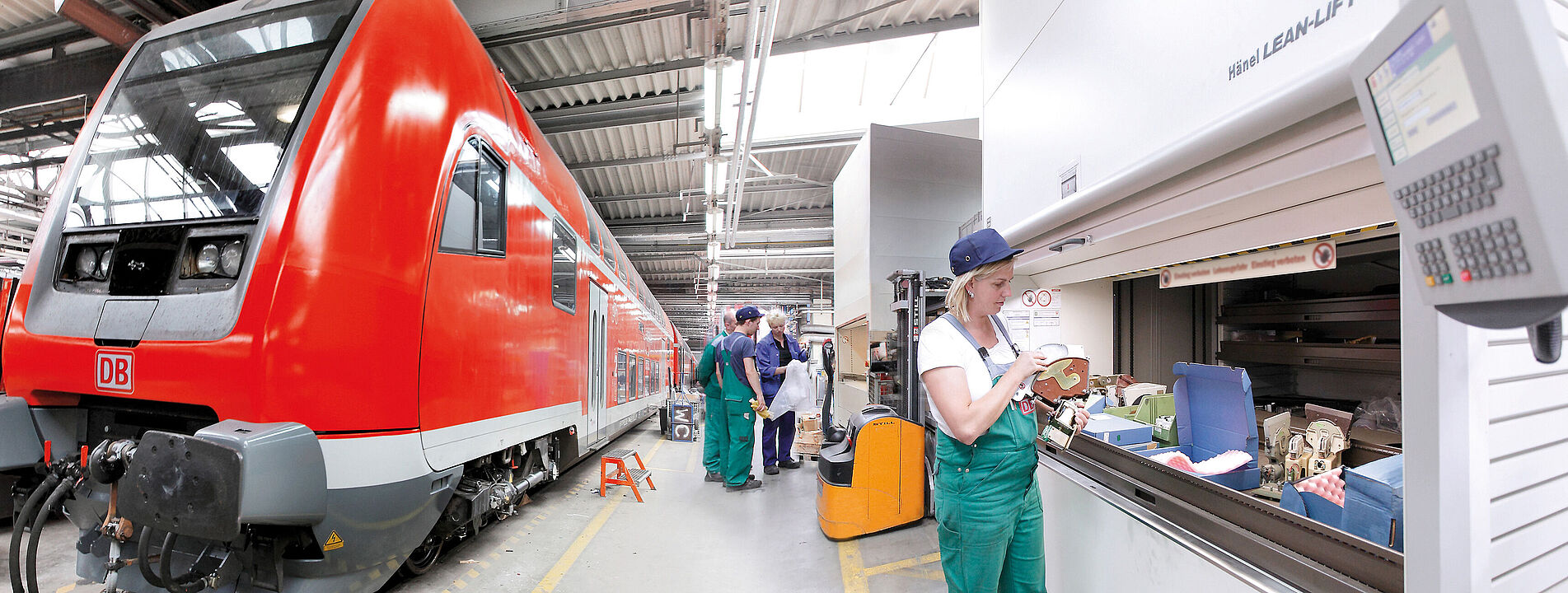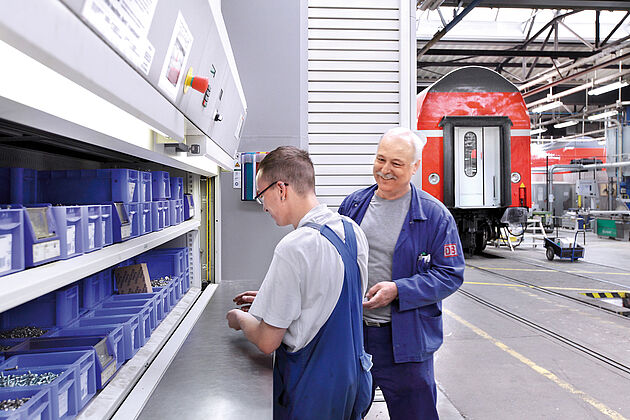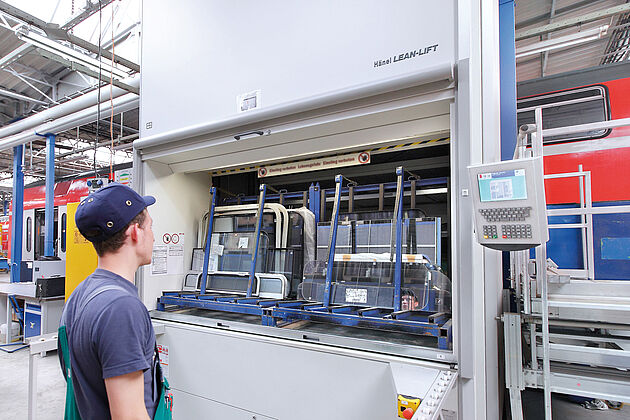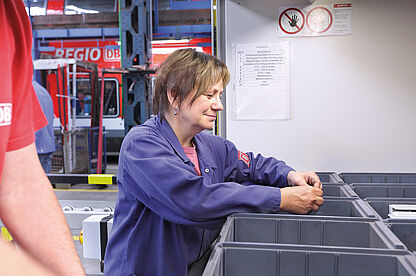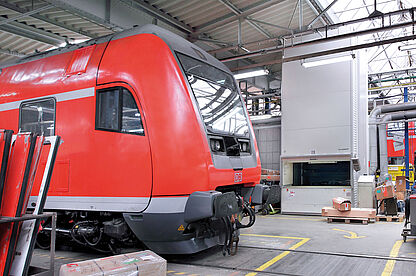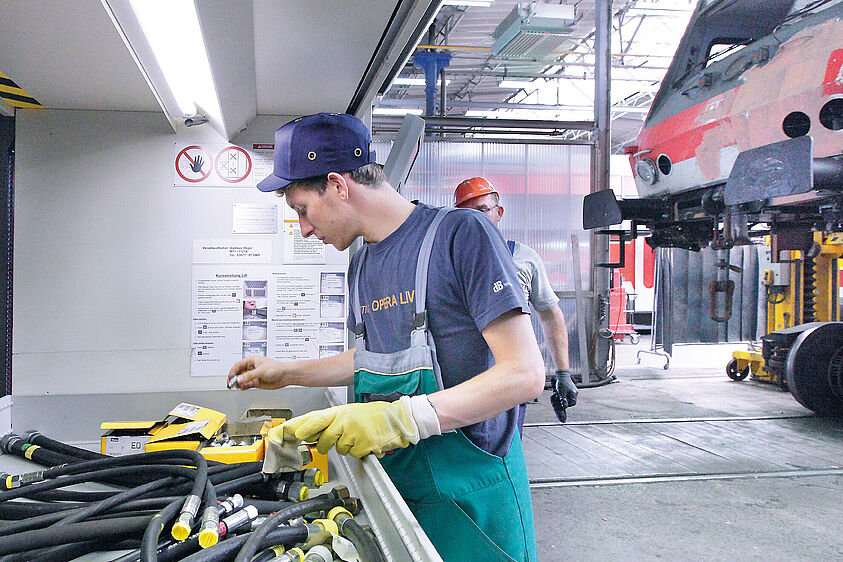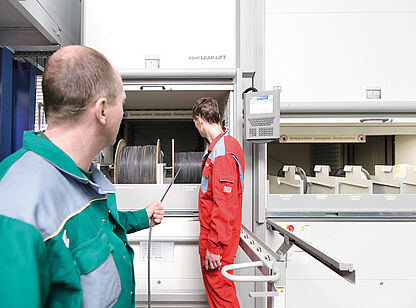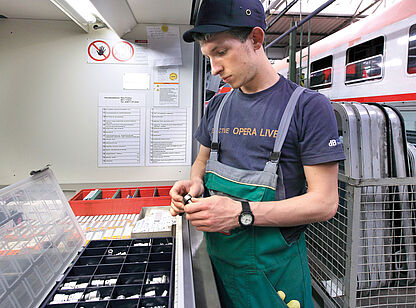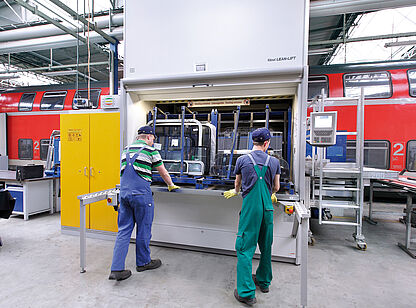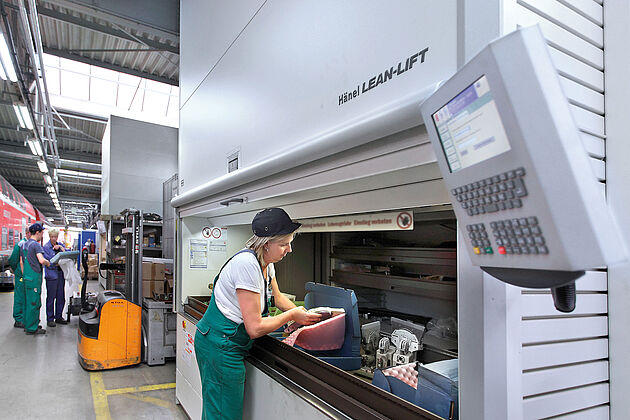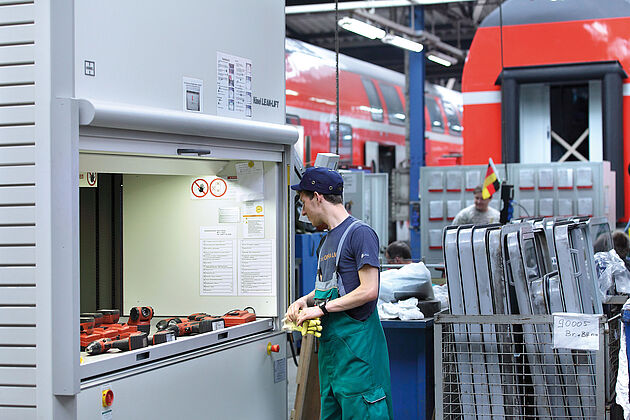Transit system maintenance parts storage
Efficient maintenance of rolling stock
An efficient warehouse is always designed to fulfill a specified task. To ensure the supply of material needed to overhaul and modernize passenger train cars, Deutsche Bahn AG, responsible for Germany’s railroad system, ordered Hänel height-optimized vertical lift storage systems that are installed directly next to the work platforms in the maintenance building located in Wittenberge, Germany. The spacesaving systems are used to safely store and provide fast access to parts, components, tools and consumables that are required for maintaining and modernizing train cars.
Deutsche Bahn maintains 16 service sites throughout the country to ensure that customer demands are met – the list of customers includes Deutsche Bahn Regio AG, DB Fernverkehr AG and DB Schenker Rail, as well as other railroad companies in Europe. The service center in Wittenberge, in the State of Brandenburg, has a long history in rolling stock maintenance dating back 135 years. The site, known officially as DB Fahrzeuginstandhaltung GmbH, employs more than 800 people who overhaul and modernize passenger cars for regional and long-distance routes, in addition to refurbishing and supplying parts and components for Deutsche Bahn.
High efficiency with space-saving vertical lift systems
Old equipment often does not ensure the process security needed today. A small problem, which is easy to resolve in modern systems, can lead to delays and, in serious cases, to complete outages that shut down operations entirely. To make sure that the maintenance processes for its train cars are always up and running smoothly, Deutsche Bahn modernized its manual buffer storage to provide fast access to material when servicing rolling stock. The project involved eight space-saving vertical lift systems and one industrial carousel system from Hänel. The automated Hänel Lean-Lift® combines storage rationalization and goods protection in one. At the center of the system is a computercontrolled positioning lift – the extractor. In front of it and behind it are the storage shelves. This is where the articles are stored in containers in height-optimized positions. The different possible heights result in exceptionally high capacity utilization. The vertical technology of the automated systems from Hänel utilizes the entire height of the building so that a storage density of up to 60 percent can be achieved. In addition, efficiency is much higher because the “putting and picking” of items in the systems is very fast, and workers do not have to walk long distances to fetch the parts or tools they need.
Holger Hammel, the project manager responsible for the Hänel systems at the Wittenberge plant, describes the improvements: “The old double-door warehouse cabinets were bursting at the seams! And the maintenance platforms were always cluttered with parts and components for the train cars. Thanks to the automated Hänel storage systems, we now have everything perfectly organized and easily accessible. What’s more, we also gained more space on the maintenance platforms – that’s a big plus.”
Modern touch-screen terminals mounted at the access points of the Lean-Lift® systems, along with integrated warehouse management software, are used to locate and retrieve containers in each Lean-Lift®. All access points are positioned at ergonomic height levels. Workers conveniently retrieve the items they need without constant bending or reaching. “The automated Hänel storage systems enabled us to optimize the throughput times for each maintenance job, and processes are more transparent as well,” says the project manager.
Optimized parts management
Faster access to required parts and components translates into economical and efficient storage that drastically reduces costs and improves parts management at the same time. Holger Hammel adds: “The logistics processes have been streamlined by using the Lean-Lift® systems. The storage systems are located right on the spot where employees need to have access to specific tools and parts – doors, sheet metal, glass, electrical units – you name it.” Thus, the Lean-Lift® used for storing brake systems is situated near the staging ramp where the chassis is separated from the train car body for maintenance work. The parts for the brake systems are refurbished and inspected. During general overhaul these parts are stored safely in the Lean-Lift®. Hydraulic lines, back-pressure valves, gauges, pressure regulators, manometers, compression couplings, gaskets and special brake tools are stored on 25 shelves. Ralf Wendland, the supervisor in charge of brakes, couplers and buffer components, says: “Thanks to the flexible Hänel storage and retrieval systems, we save enormous amounts of time, storage space and money. Our maintenance processes are also much better. Dynamic storage enables us to rationalize work processes and reduce walking distances when fetching parts and tools – and that really saves a lot of time. The Hänel storage systems support us in achieving our 12-day target for completing a standard overhaul job.”
Safe storage of fragile glass panes
After a period of eight years or an in-service performance of about 1.5 million kilometers, a train car is brought to Wittenberge for a standard overhaul. In many cases the train cars need to be modernized or even completely restored. Ralf Wendland explains: “For storing fragile windows, we have two containers in a Lean-Lift® equipped with special receptacles for holding up to 16 windowpanes each. The system features an enlarged access area and two transport support rails for removing the panes quickly and easily.” The other ten containers in the system hold door locks, rubber strips, window and door gaskets, as well as cleaning cloths and similar materials needed by employees.
Storage for cable reels
For complete modernizations and corrosion removal, the platform at the far end of the service center is equipped with two special Hänel systems for storing large and small cable reels. The eight containers in the Lean-Lift®, which is almost six meters high but only 1.3 meters wide, have special fittings to hold two large cable reels each, with a payload of up to 1,000 kilograms. Support rails on both sides make it easy to slide the containers out and change the cable reels as needed.
Special protection for electronic components
Particularly sensitive electronic components like plug-in boards or controllers for doors and air conditioning are kept in a special Lean-Lift® with ESD prevention features.
For example, all 22 containers have a special finish to protect items from damage that could be caused by electrostatic discharges. In addition, the access points can also be locked. Thus electronic components are safeguarded against ESD, light and dust.
Locked containers for more inventory control
Ralf Wendland adds: “A second Lean-Lift® is equipped with a container that is supplied with electric power – this is where we store items needed for the interiors of our train cars. When they are put into storage, we are able to charge the device batteries while they are in the container. Furthermore, specified containers in this Lean-Lift® are locked. They can only be activated with a password entered at the terminal. This gives us better inventory control and retrieval management when it comes to valuable electronics. And things stay organized and clean.”
Heavy loads and small parts
Heavy spacer and buffer plates, steel sheeting, junction plates and stops are kept in a Lean-Lift® with a payload capacity of up to 600 kilograms per container. Here again support rails can be pulled out for ergonomic and more convenient removal of heavy components from the containers.
Small items such as screws, nuts, bolts, springs and pins, as well as consumables, are stored in a vertical Hänel Rotomat® industrial carousel. An external supplier keeps the Rotomat® containers filled according to the Kanban principle. Inside, 28 multifunctional shelves can be arranged variably using dividers, split-shelving elements and punched slot grids.


